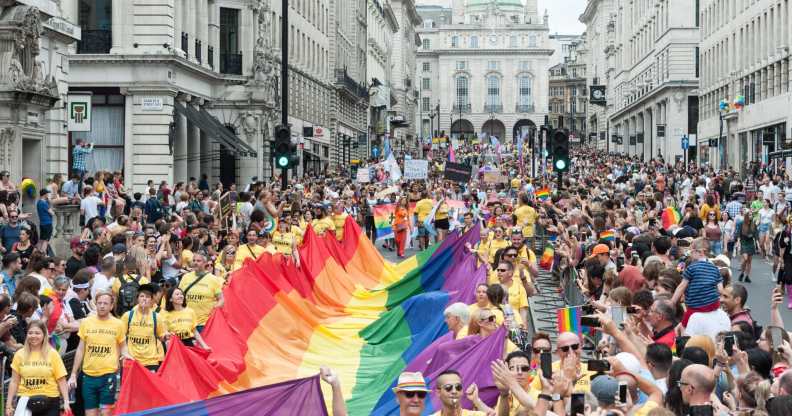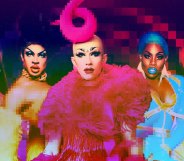More Brits identify as lesbian, gay or bisexual than ever before – including 1 in 10 young women

Pride Parade in London, 2019. (Getty)
More adults identify as lesbian, gay or bisexual than ever before, with one in 12 young people saying they are LGB, according to new official figures.
Eight per cent of 16 to 24-year-olds described themselves as LGB in the 2020 Annual Population Survey, it was revealed for the first time on Wednesday (25 May).
This is up from 6.6 per cent in 2019 and 4.1 per cent in 2016, according to data from the Office of National Statistics (ONS).
It’s a shift that pollsters weren’t too surprised by, given that there has been “an increasing trend for this age group since 2014”, the ONS said.
One in 20 young Brits (5.3 per cent) said they were bisexual, 2.7 per cent answered gay or lesbian and 1.3 per cent said other, while 3.4 per cent said they didn’t know or refused to answer.
More than one in 10 (11.4 per cent) of women aged 16 to 24 identified themselves as lesbian, gay or bisexual, the first time this percentage has topped 10 per cent.
This is in spite of anti-trans campaigners claiming lesbians are facing a mass “extinction“.
In 2014, when the estimates first began, fewer than 3.1 per cent of young women said they were LGB+.
The figures – which do not estimate the UK’s trans population – give a snapshot of a nation where more younger people are embracing openness and acceptance than ever before – and that’s not changing anytime soon.
There has been a “decreasing trend” in young people identifying as heterosexual since 2014, with 87.3 per cent in 2020 identifying as straight.

An LGBT+ Pride parade in Cardiff, Wales. (Barcroft Media via Getty Images)
Older age groups saw smaller numbers of people identifying as LGB – though these figures have generally climbed over the years.
The percentage of all adults saying they are LGB+ stood at 3.1 per cent in 2020, up from 2.7 per cent in 2019 and nearly double the 1.7 per cent recorded in 2015. This is the highest percentage since the ONS began estimating the UK’s LGB population.
This suggests that around 1.65 million people in the UK said they are LGB+ in 2020 with a further 350,000 people recording “other”.
Only two per cent of Britons aged 25 to 35 said they were LGB+ in 2020, falling to less than one per cent for age groups above that.
The number of self-identified heterosexuals in the general population has fallen from 95.3 per cent in 2014 to 93.6 per cent in 2020.
Northern Ireland had the highest number of people identifying as straight in the 2020 figures, followed by the east of England. Northern Ireland and Wales’ queer populations have remained vastly unchanged since the annual survey began.
The ONS’ annual Population Survey analyses the household population aged 16 and over across the UK.

